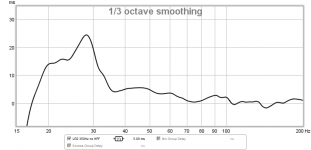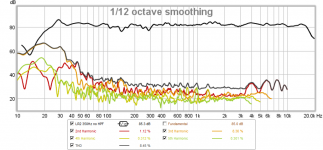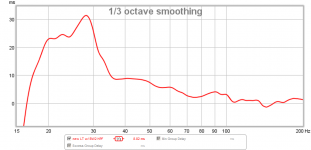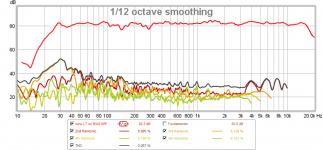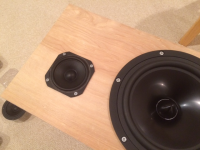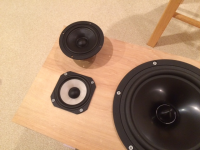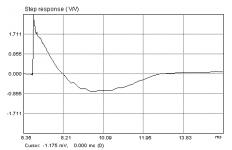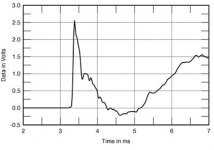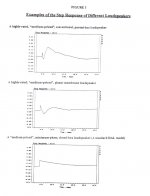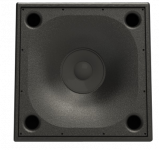Byrtt,
Again, thank you for the great analysis. My internal box volume truly is 24liters but then there is some bracing and RS225 self volume so I am guessing closer to 22 liters when all is said and done. However, doesn't the pink fiberglass stuffing change the box Q as well as some wall flex of the XPS walls? I can measure the box impedance with the wonderful DATS tool and see what the impedance sweep provides. The RS225-8 measured parameters were close but Qts a bit higher than spec. IIRC I measured Qts of 0.43 vs spec of 0.38. Fs was close as well as Vas.
Right fiberglass stuffing and wall flex most add virtual volume, sharing a DATS sweep sometime would be interesting
Flattest response and compromise best spring load keeping Xmax reasonable think is Q of 0.707 but this build maybe at present is a little lower Q which then give better transient response spec but less spring load.
Byrtt,
You are right about the HPF causing the excessive GD. I bypassed the HPF and GD dropped to 5ms at 40Hz as you predict but the HD below 50Hz is not very good. So there is a tradeoff I guess. But then, if you don't have much content below 50Hz, you don't care about the HD there.
Although, the Linkwitz transform is probably excessive. I just measured the speaker impedancewith DATS and got 50Hz and Qts of 0.61. So I will re-calculate the LT using this exact value and see if it reduces excursion.
Here is the new group delay without the high pass filter:
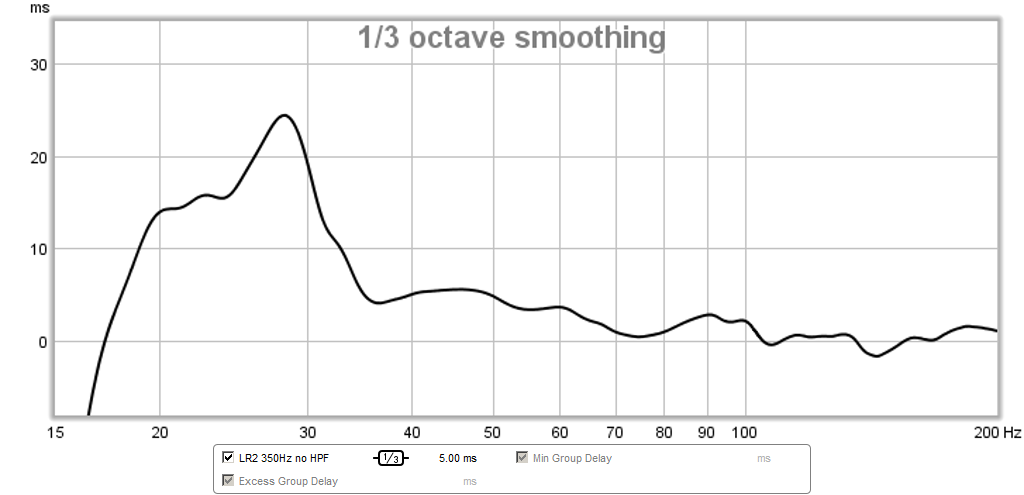
But then the corresponding harmonic distortion goes to hell:
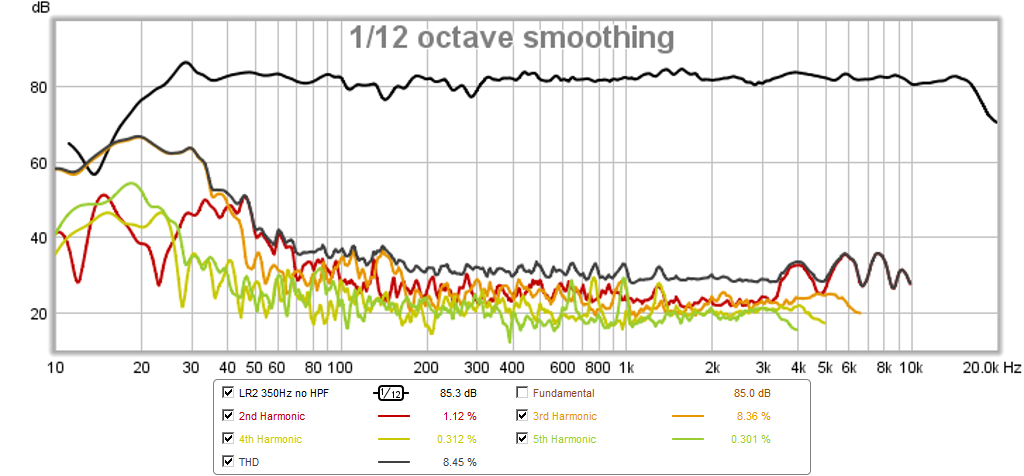
You are right about the HPF causing the excessive GD. I bypassed the HPF and GD dropped to 5ms at 40Hz as you predict but the HD below 50Hz is not very good. So there is a tradeoff I guess. But then, if you don't have much content below 50Hz, you don't care about the HD there.
Although, the Linkwitz transform is probably excessive. I just measured the speaker impedancewith DATS and got 50Hz and Qts of 0.61. So I will re-calculate the LT using this exact value and see if it reduces excursion.
Here is the new group delay without the high pass filter:

But then the corresponding harmonic distortion goes to hell:

Attachments
An improved GD compromise
I recalculated the Linkwitz transform and used a 2nd order Butterworth HPF at 30Hz and this seems to provide a good compromise of cutting the GD down to about 8.5ms while keeping the HD at 50Hz and 40Hz almost the same as the earlier case where the GD was 15ms long. So basically cut the GD in half and kept distortion above 40Hz the same. The 30Hz HD figure is higher now but don't have too much content there.
Here is the new GD:
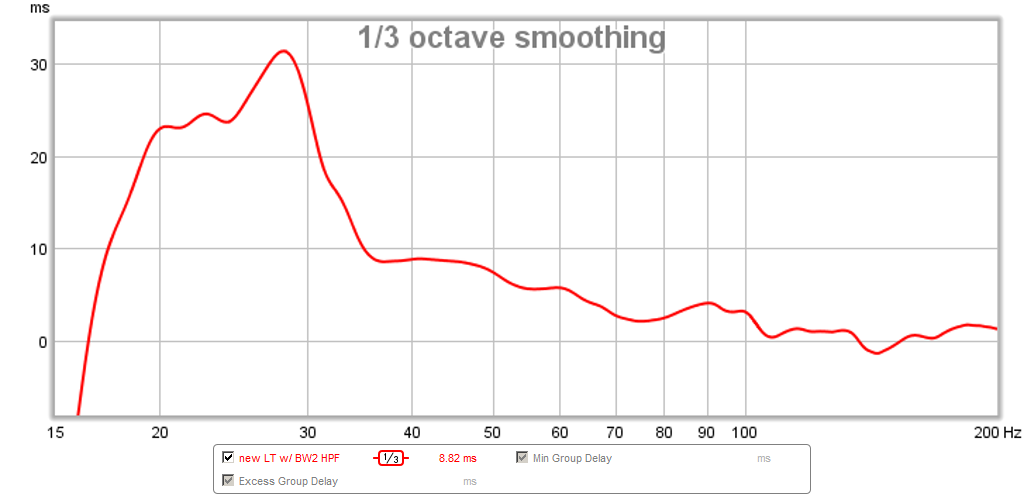
Corresponding HD:
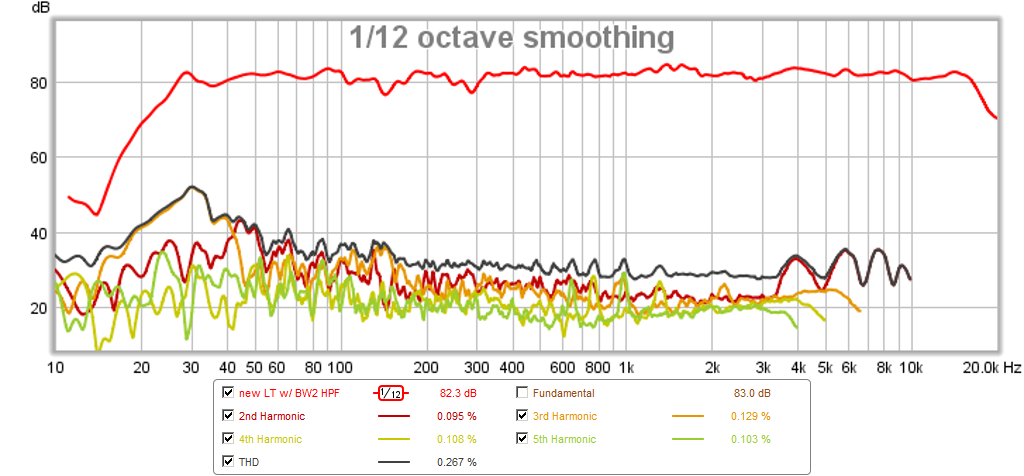
I recalculated the Linkwitz transform and used a 2nd order Butterworth HPF at 30Hz and this seems to provide a good compromise of cutting the GD down to about 8.5ms while keeping the HD at 50Hz and 40Hz almost the same as the earlier case where the GD was 15ms long. So basically cut the GD in half and kept distortion above 40Hz the same. The 30Hz HD figure is higher now but don't have too much content there.
Here is the new GD:

Corresponding HD:

Attachments
The graph that the Tymphany/Peerless/Scanspeak/Vifa Group doesn't want you to see
Ok, so with a few minutes to spare before heading off to work, curiosity set in. Several folks have asked me if a poor man's version of this speaker could be made with say, the TC9FD or TG9FD? If so, how would it compare to the venerable 10F? It comes as no surprise that the 10F/TG9FD/TC9FD bear a striking family resemblance down to their common bolt hole circle diameter and driver hole cutout diameter. What this means is that it was very easy to plop a TG9FD or a TC9FD into this speaker for a quick test and a listen. So that is exactly what I did. Here is a photo of the TG9FD10-08 fiberglass cone, paper dustcap installed in this speaker (with 10F/8424 sitting outside watching his budget cousin take his home):
To be fair, the 10F/8424 measures better in the CSD department and has much higher sensitivity - but that sensitivity is lost because I had to apply -4.2dB gain (cut) to balance with the RS225-8 in this particular speaker. For the TG9FD, I used -0.8dB gain in order to level match the RS225-8. I did the same thing for the TC9FD18-08 (paper cone and paper dustcap):

Now here is the TC9FD installed:

How well do they measure - exceedingly well. I also threw in an out-of-family Dayton PS95-8 just for grins and to see what a remarkable performer the Danish Cousins really are. The SPL vs frequency measurement and harmonic distortion on the 10F/TG9FD/TC9FD are all very similar. I would say that the TC9FD has an edge on a slightly higher treble presence, but the TG9FD is probably closest to the 10F/8424 in overall feel which is not surprising as they both have fiberglass cones. I also threw in the Dayton PS95-8 just to see what happens when an out-of-family driver sits in this same box. It clearly demonstrates the smoothness of the Danish Cousins. The RS225-8 woofer tested here has the newly revised Linkwitz transform and mild high pass filter to enable the 8ms group delay figure at 40Hz. Here is the SPL vs frequency with no gating over the whole range:
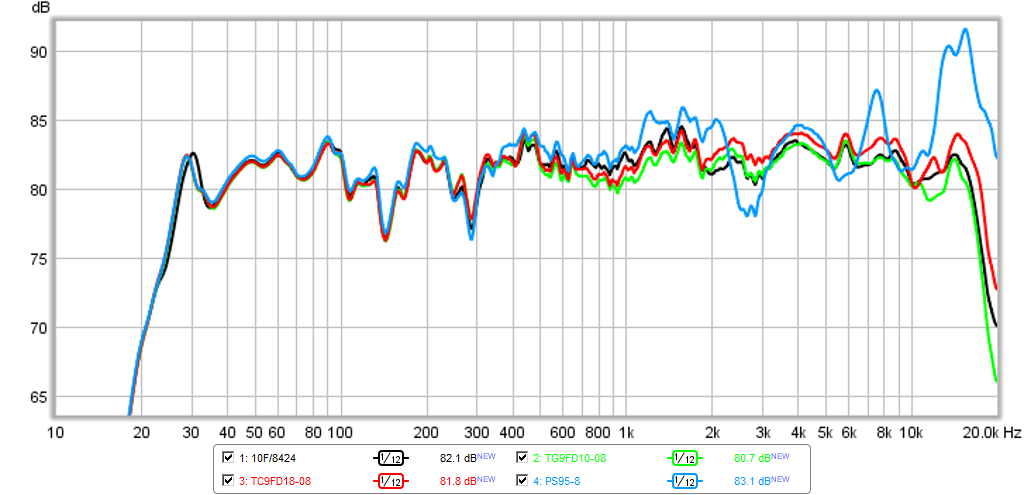
Here is the harmonic distortion of the 10F/8424:
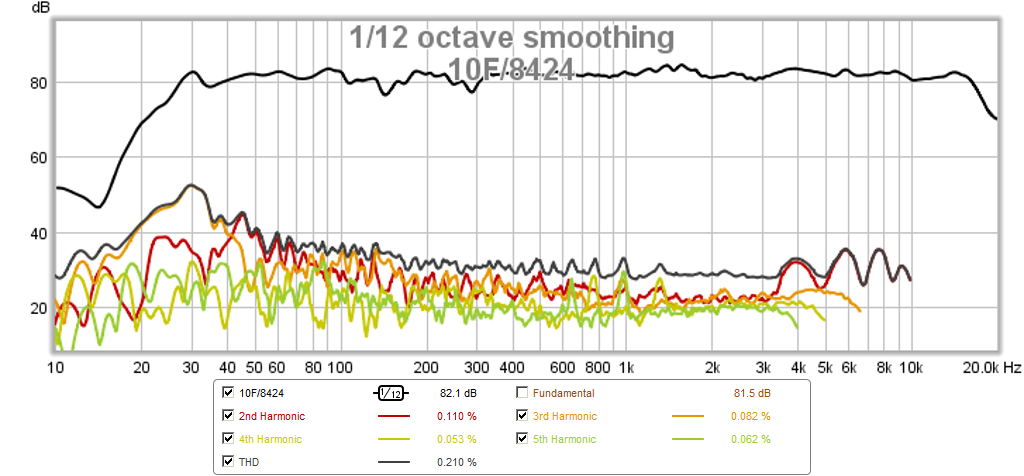
HD of TG9FD:
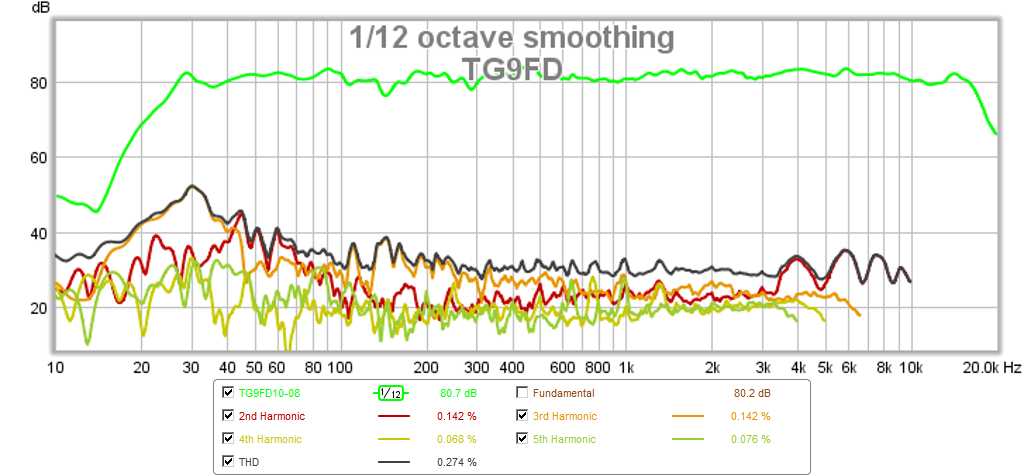
HD of TC9FD:
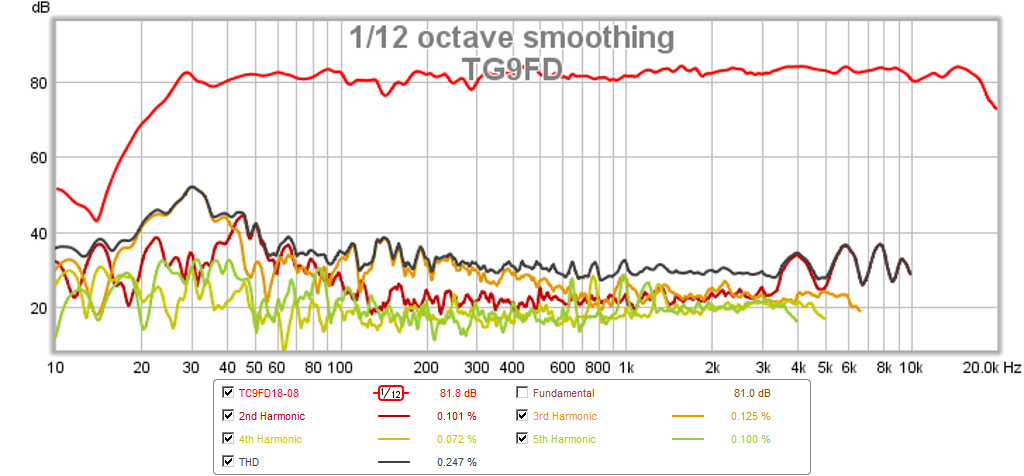
HD of PS95-8:
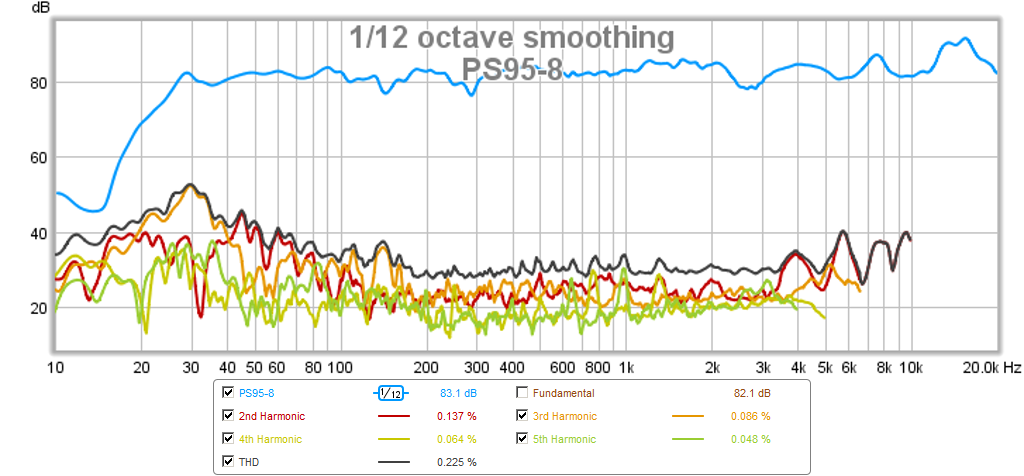
Finally, applying a 4ms gate, and 1/48th octave smoothing, we can see how closely the drivers match up:
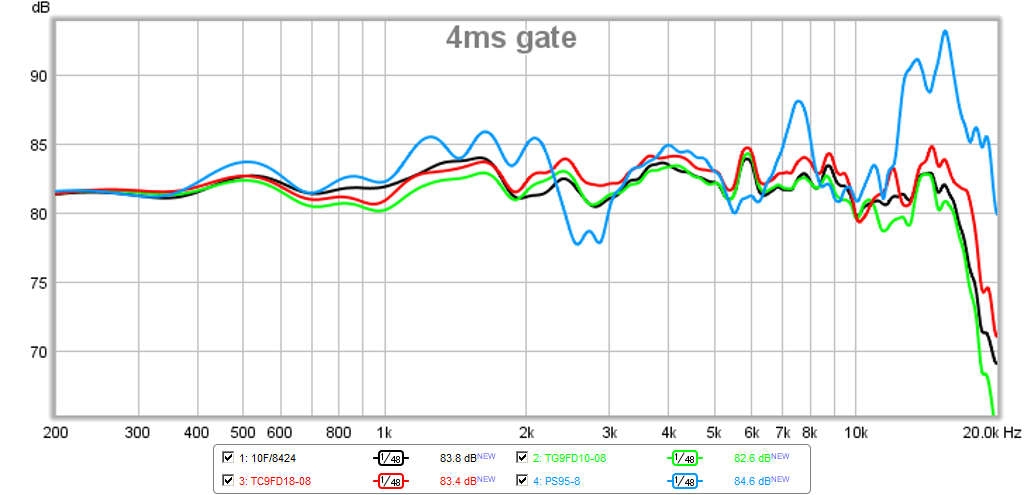
How do Danish Cousins sound? They all sound great, I had a hard time hearing a difference. SOund clips are provided for you to listen for yourself. The PS95-8 has a lot of resonant peaks - making it a perfect candidate for a high RESA driver (http://www.diyaudio.com/forums/full-range/273348-resonance-enhanced-selective-amplification-resa-aka-ddr.html)
In summary, I think that the above data shows that one can build a $140/pair reference standard studio monitors using the TC9FD, or $160 monitors using the TG9FD (cost of drivers only) vs $320 for the 10F/8424 price tag. You may give up some in the CSD and transient detail department, but, boy, one might be hard-pressed to tell the difference.
This may make a good case for why the TC9FD/TG9FD are still the Best Bang for the Buck 3.5in class drivers.
Sound clips for this comparison are below (change .asc to .mp3 extension in order to listen).
Ok, so with a few minutes to spare before heading off to work, curiosity set in. Several folks have asked me if a poor man's version of this speaker could be made with say, the TC9FD or TG9FD? If so, how would it compare to the venerable 10F? It comes as no surprise that the 10F/TG9FD/TC9FD bear a striking family resemblance down to their common bolt hole circle diameter and driver hole cutout diameter. What this means is that it was very easy to plop a TG9FD or a TC9FD into this speaker for a quick test and a listen. So that is exactly what I did. Here is a photo of the TG9FD10-08 fiberglass cone, paper dustcap installed in this speaker (with 10F/8424 sitting outside watching his budget cousin take his home):
To be fair, the 10F/8424 measures better in the CSD department and has much higher sensitivity - but that sensitivity is lost because I had to apply -4.2dB gain (cut) to balance with the RS225-8 in this particular speaker. For the TG9FD, I used -0.8dB gain in order to level match the RS225-8. I did the same thing for the TC9FD18-08 (paper cone and paper dustcap):

Now here is the TC9FD installed:

How well do they measure - exceedingly well. I also threw in an out-of-family Dayton PS95-8 just for grins and to see what a remarkable performer the Danish Cousins really are. The SPL vs frequency measurement and harmonic distortion on the 10F/TG9FD/TC9FD are all very similar. I would say that the TC9FD has an edge on a slightly higher treble presence, but the TG9FD is probably closest to the 10F/8424 in overall feel which is not surprising as they both have fiberglass cones. I also threw in the Dayton PS95-8 just to see what happens when an out-of-family driver sits in this same box. It clearly demonstrates the smoothness of the Danish Cousins. The RS225-8 woofer tested here has the newly revised Linkwitz transform and mild high pass filter to enable the 8ms group delay figure at 40Hz. Here is the SPL vs frequency with no gating over the whole range:

Here is the harmonic distortion of the 10F/8424:

HD of TG9FD:

HD of TC9FD:

HD of PS95-8:

Finally, applying a 4ms gate, and 1/48th octave smoothing, we can see how closely the drivers match up:

How do Danish Cousins sound? They all sound great, I had a hard time hearing a difference. SOund clips are provided for you to listen for yourself. The PS95-8 has a lot of resonant peaks - making it a perfect candidate for a high RESA driver (http://www.diyaudio.com/forums/full-range/273348-resonance-enhanced-selective-amplification-resa-aka-ddr.html)
In summary, I think that the above data shows that one can build a $140/pair reference standard studio monitors using the TC9FD, or $160 monitors using the TG9FD (cost of drivers only) vs $320 for the 10F/8424 price tag. You may give up some in the CSD and transient detail department, but, boy, one might be hard-pressed to tell the difference.
This may make a good case for why the TC9FD/TG9FD are still the Best Bang for the Buck 3.5in class drivers.
Sound clips for this comparison are below (change .asc to .mp3 extension in order to listen).
Attachments
-
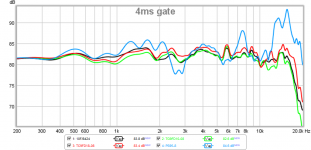 10f-tg9fd-tc9fd-ps95-comparo-fast-fr-4ms-gate.png97.5 KB · Views: 4,179
10f-tg9fd-tc9fd-ps95-comparo-fast-fr-4ms-gate.png97.5 KB · Views: 4,179 -
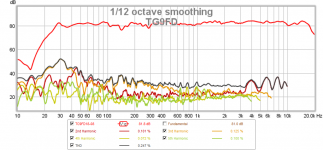 tc9fd-comparo-fast-hd.png152.2 KB · Views: 4,247
tc9fd-comparo-fast-hd.png152.2 KB · Views: 4,247 -
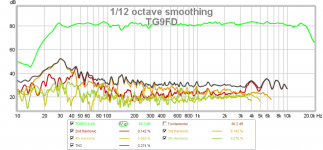 tg9fd-comparo-fast-hd.png153.6 KB · Views: 4,227
tg9fd-comparo-fast-hd.png153.6 KB · Views: 4,227 -
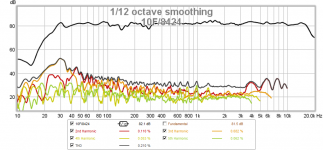 10f-8424-comparo-fast-hd.png153.7 KB · Views: 4,224
10f-8424-comparo-fast-hd.png153.7 KB · Views: 4,224 -
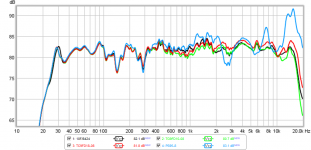 10f-tg9fd-tc9fd-ps95-comparo-fast-fr.png107.6 KB · Views: 4,244
10f-tg9fd-tc9fd-ps95-comparo-fast-fr.png107.6 KB · Views: 4,244 -
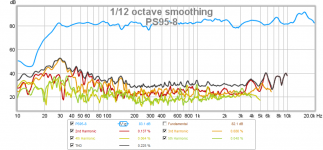 ps95-8-comparo-fast-hd.png157.7 KB · Views: 4,235
ps95-8-comparo-fast-hd.png157.7 KB · Views: 4,235 -
10f-8424-comparo-fast-clip-1.asc1.7 MB · Views: 181
-
tg9fd-comparo-fast-clip-1.asc1.7 MB · Views: 159
-
tc9fd-comparo-fast-clip-1.asc1.7 MB · Views: 165
-
ps95-8-comparo-fast-clip-1.asc1.7 MB · Views: 156
Last edited:
>>>TC9FD has an edge on a slightly higher treble presence<<<
I'm a little surprised.
Tnx xrk, appreciate. I think you saved me $$. I'm staying with TC9.
I have not had a chance to listen to more than the one song I recorded. I think transient details may come through on the 10F better due to better cumulative spectral decay (CSD) which has been quantitatively measured to be better than the TC9FD. I think there is a Klang and Ton article in the Bang for the Buck thread. But for most listening purposes, if you are not a driver snob, the plastic framed TC9FD "TV Set" driver works almost as good.
I will do more extensive listening over coming days and weeks and get an informed opinion of the differences (if I can hear it). Just please don't be too quick to write of the 10F based on a single test track.
I messed up with the photo uploads on previous post. Here are photos...
Attachments
Last edited:
Ok, so with a few minutes to spare before heading off to work, curiosity set in. Several folks have asked me if a poor man's version of this speaker could be made with say, the TC9FD or TG9FD? If so, how would it compare to the venerable 10F? It comes as no surprise that the 10F/TG9FD/TC9FD bear a striking family resemblance down to their common bolt hole circle diameter and driver hole cutout diameter. What this means is that it was very easy to plop a TG9FD or a TC9FD into this speaker for a quick test and a listen. So that is exactly what I did. Here is a photo of the TG9FD10-08 fiberglass cone, paper dustcap installed in this speaker (with 10F/8424 sitting outside watching his budget cousin take his home):
.....................................
.....................................
.....................................
In summary, I think that the above data shows that one can build a $140/pair reference standard studio monitors using the TC9FD, or $160 monitors using the TG9FD (cost of drivers only) vs $320 for the 10F/8424 price tag. You may give up some in the CSD and transient detail department, but, boy, one might be hard-pressed to tell the difference.
This may make a good case for why the TC9FD/TG9FD are still the Best Bang for the Buck 3.5in class drivers.
Sound clips for this comparison are below (change .asc to .mp3 extension in order to listen).
i'm not sure why you say "The graph that the Tymphany/Peerless/Scanspeak/Vifa Group doesn't want you to see"
as Scanspeak have been a separate entity to Tymphany for many years, see the news from 2009 http://www.scan-speak.dk/news/20090116a.pdf
check the Scan-Speak news pages there are more changes recently!
i'm not sure why you say "The graph that the Tymphany/Peerless/Scanspeak/Vifa Group doesn't want you to see"
as Scanspeak have been a separate entity to Tymphany for many years, see the news from 2009 http://www.scan-speak.dk/news/20090116a.pdf
check the Scan-Speak news pages there are more changes recently!
Just saying that ScanSpeak would rather not like to see how former same-family drivers priced at 1/5th and 1/10th the cost seem to measure very closely to each other. I guess Tymphany/Vifa would like us to see this though
This post shows earlier discussion about the family resemblance...
http://www.diyaudio.com/forums/full-range/268626-vifa-tc9fd18-08-best-bang-buck-43.html#post4262299
The Discovery line from Scan Speak was based on the Vifa drivers from that same time frame. Most probably the 10F is based on the Vifa 10BGS. The TG9 is the successor to that 10 BGS driver in the Vifa line up. Not saying they are the same, but one can not deny the family resemblance.
Just look at the Vifa XT25TG30-04 1" Ring Radiator and the Scan Speak Discovery R2604/8320 1" Ring Radiator to see more of these family resemblances all dating back to that same joint venture from the past.
http://www.diyaudio.com/forums/full-range/268626-vifa-tc9fd18-08-best-bang-buck-43.html#post4262299
The Discovery line from Scan Speak was based on the Vifa drivers from that same time frame. Most probably the 10F is based on the Vifa 10BGS. The TG9 is the successor to that 10 BGS driver in the Vifa line up. Not saying they are the same, but one can not deny the family resemblance.
Just look at the Vifa XT25TG30-04 1" Ring Radiator and the Scan Speak Discovery R2604/8320 1" Ring Radiator to see more of these family resemblances all dating back to that same joint venture from the past.
Last edited:
Thanks for the link Wesayso. There is a great history lesson of SS here. At the end of the article it says that the marketing that went into the 10F in 2012 was the largest investment ever by SS for a product. The 10F is based on the 2009 Vifa and it is why I thought the data showing how the roots of the 10F as embodied by the TC9 and TG9 still seem to be very evident in the similarity of the flatness of the response, the same level of HD, and overall character of sound.
In 2012, Scan-Speak is marketed in Japan with the STEREO magazine. Two drivers of the 10F type are sold with the magazine. This is by far the largest marketing investment in the history of Scan-Speak.
Last edited:
Whoa
Thanks.
Nice copper foil inductor on your avatar - do those really sound better? I am contemplating a passive XO design for this speaker and the possibility of magnet wire vs copper foil ribbon chokes is certainly a trade space. pricey items - are they worth it?
First Order XO works!
So it looks like if one wants to get linear phase, 1st order is the way to go. I set the XO as 6dB/oct Butterworth at 350Hz (electrical). Acoustically, the XO appears closer to 600Hz from the data. Anyhow, it works and the distortion for the 10F or RS225 does not seem to be a problem. Based on the measurements below, I think this may almost be able to do square waves.
Here is the acoustic XO:
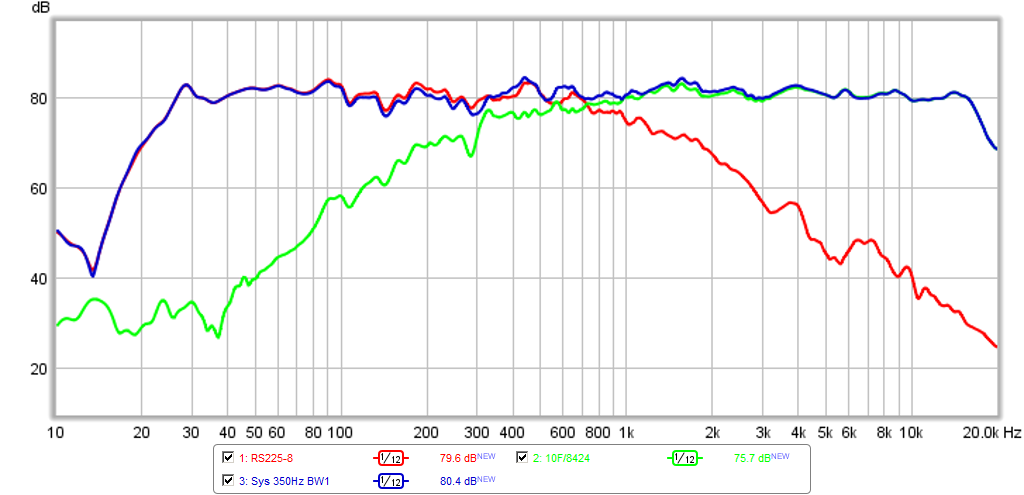
Harmonic distortion:
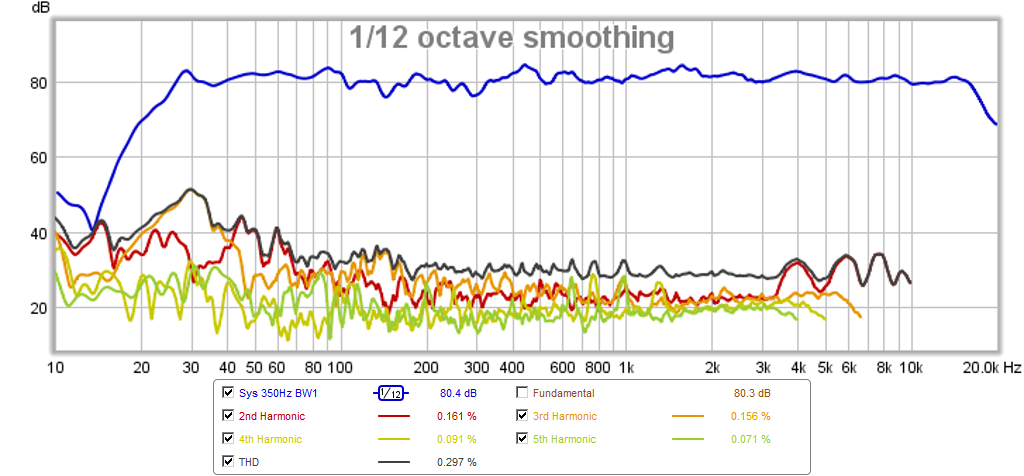
Impulse response:
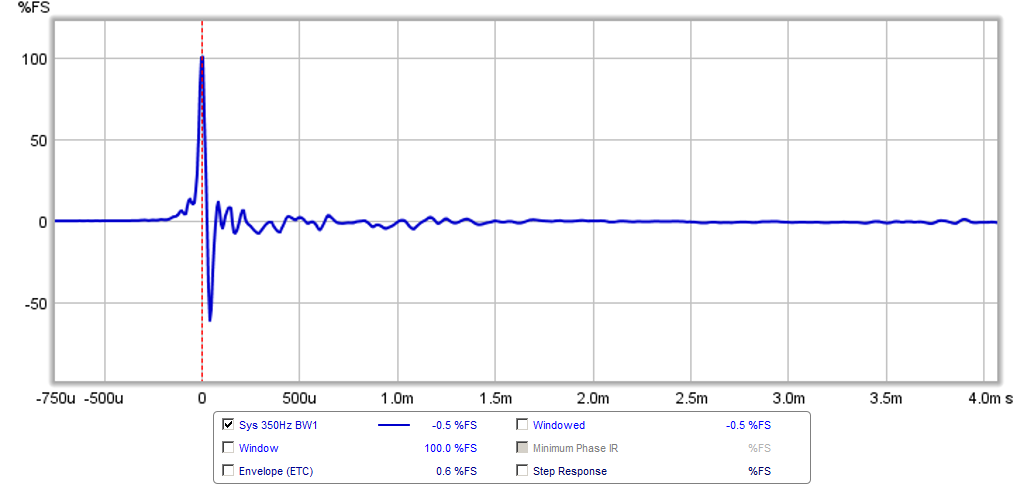
Step function - very nice:
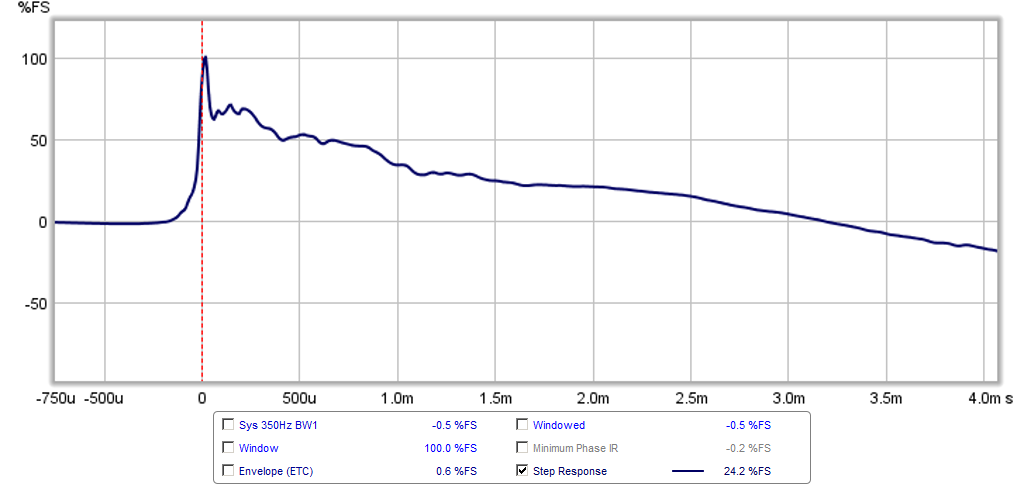
Group delay is 8ms at 40Hz:
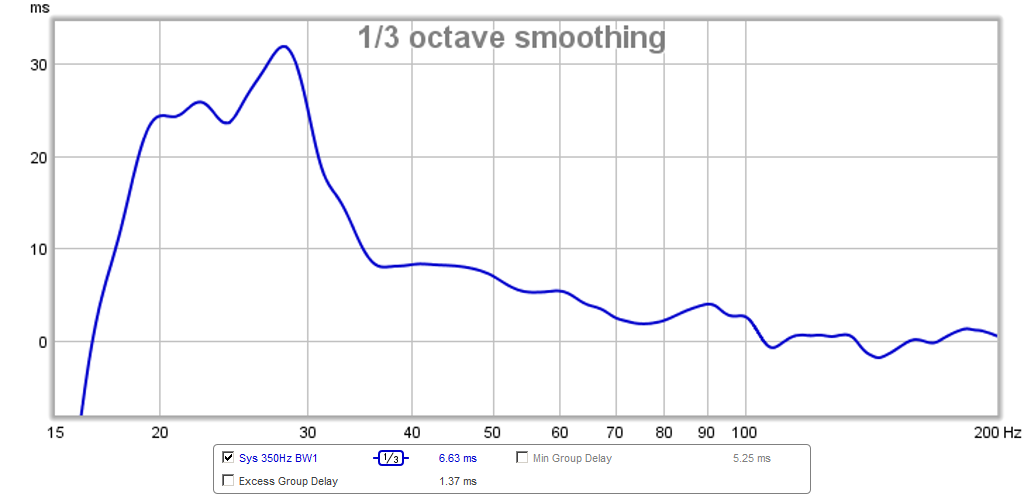
Absolute Phase:
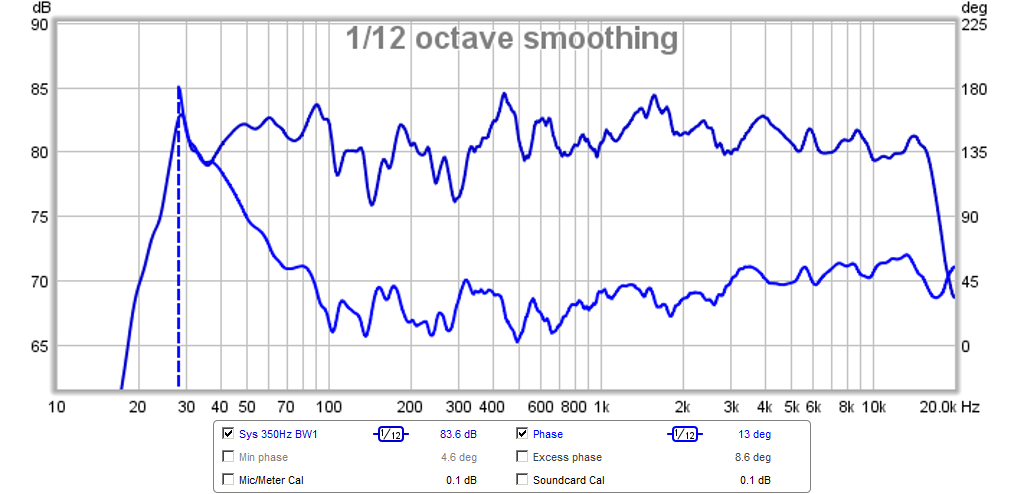
With 4ms gate the Absolute phase and frequency response look like this:
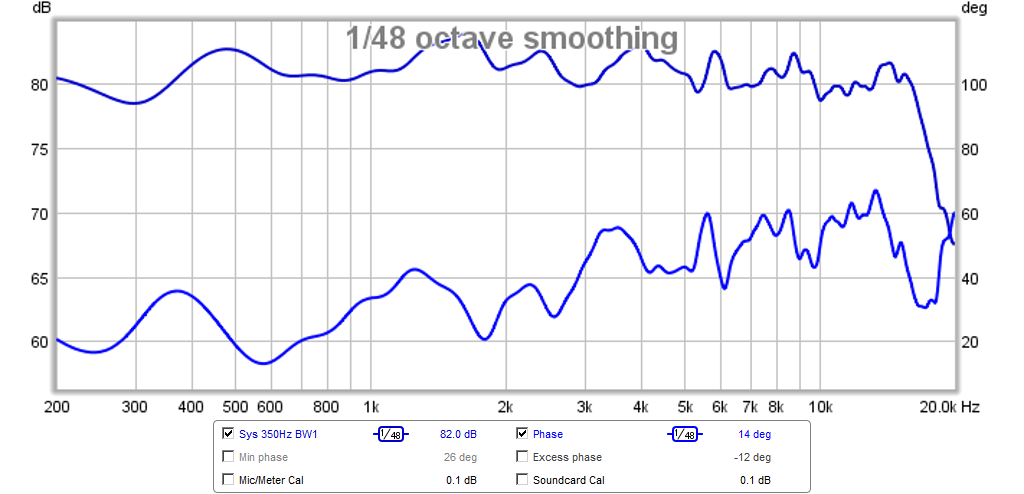
I am listening to it now and it sounds very nice. Will give it more time, but so far so good.
I adjusted the time delay on the 10F to 0.22ms from 0.26ms and I think this step response looks closer to "ideal"?
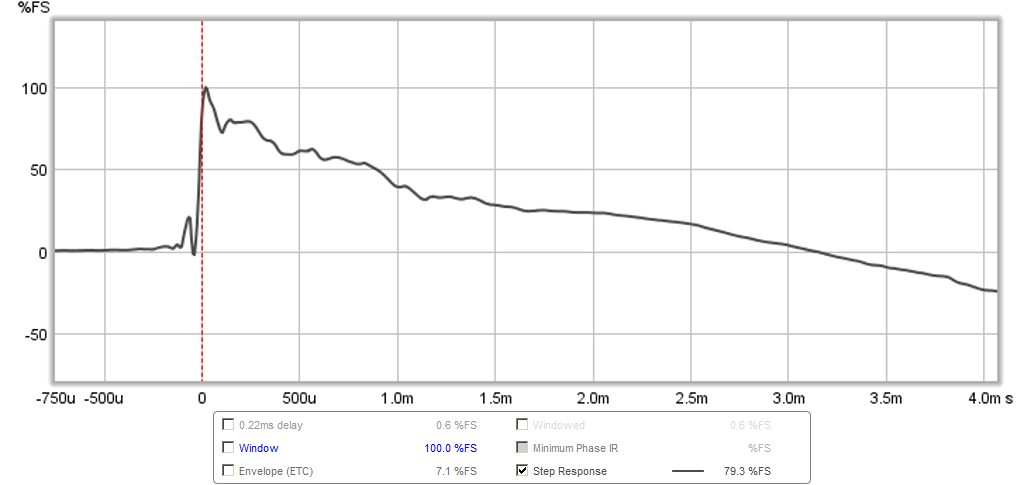
I know Wesayso will let me know if this is what he was looking for...
So it looks like if one wants to get linear phase, 1st order is the way to go. I set the XO as 6dB/oct Butterworth at 350Hz (electrical). Acoustically, the XO appears closer to 600Hz from the data. Anyhow, it works and the distortion for the 10F or RS225 does not seem to be a problem. Based on the measurements below, I think this may almost be able to do square waves.
Here is the acoustic XO:

Harmonic distortion:

Impulse response:

Step function - very nice:

Group delay is 8ms at 40Hz:

Absolute Phase:

With 4ms gate the Absolute phase and frequency response look like this:

I am listening to it now and it sounds very nice. Will give it more time, but so far so good.
I adjusted the time delay on the 10F to 0.22ms from 0.26ms and I think this step response looks closer to "ideal"?

I know Wesayso will let me know if this is what he was looking for...
Attachments
-
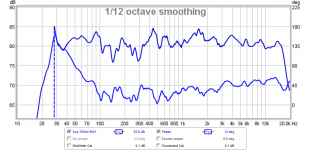 10f-8424-rs225-8-fast-bw1-350hz-phsae.png97.3 KB · Views: 42,751
10f-8424-rs225-8-fast-bw1-350hz-phsae.png97.3 KB · Views: 42,751 -
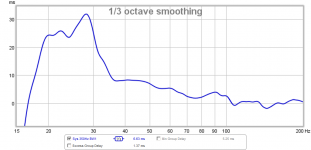 10f-8424-rs225-8-fast-bw1-350hz-gd.png50.5 KB · Views: 3,271
10f-8424-rs225-8-fast-bw1-350hz-gd.png50.5 KB · Views: 3,271 -
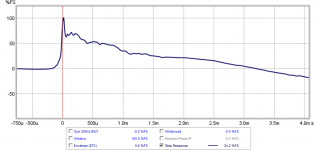 10f-8424-rs225-8-fast-bw1-350hz-step.png59.2 KB · Views: 2,799
10f-8424-rs225-8-fast-bw1-350hz-step.png59.2 KB · Views: 2,799 -
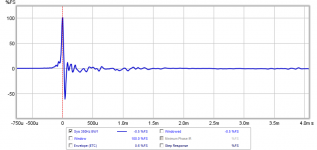 10f-8424-rs225-8-fast-bw1-350hz-ir.png44.5 KB · Views: 3,291
10f-8424-rs225-8-fast-bw1-350hz-ir.png44.5 KB · Views: 3,291 -
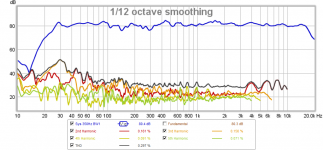 10f-8424-rs225-8-fast-bw1-350hz-hd.png152.9 KB · Views: 2,837
10f-8424-rs225-8-fast-bw1-350hz-hd.png152.9 KB · Views: 2,837 -
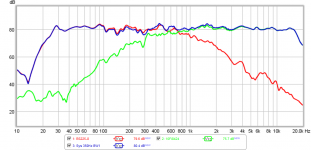 10f-8424-rs225-8-fast-bw1-350hz-xo.png78.1 KB · Views: 45,750
10f-8424-rs225-8-fast-bw1-350hz-xo.png78.1 KB · Views: 45,750 -
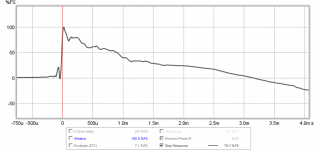 10f-8424-rs225-8-fast-bw1-350hz-step-0.22ms.png42.4 KB · Views: 42,734
10f-8424-rs225-8-fast-bw1-350hz-step-0.22ms.png42.4 KB · Views: 42,734 -
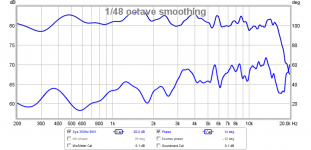 10f-8424-rs225-8-fast-bw1-350hz-phase-hires.png81.1 KB · Views: 3,101
10f-8424-rs225-8-fast-bw1-350hz-phase-hires.png81.1 KB · Views: 3,101
Last edited:
Compare your result:
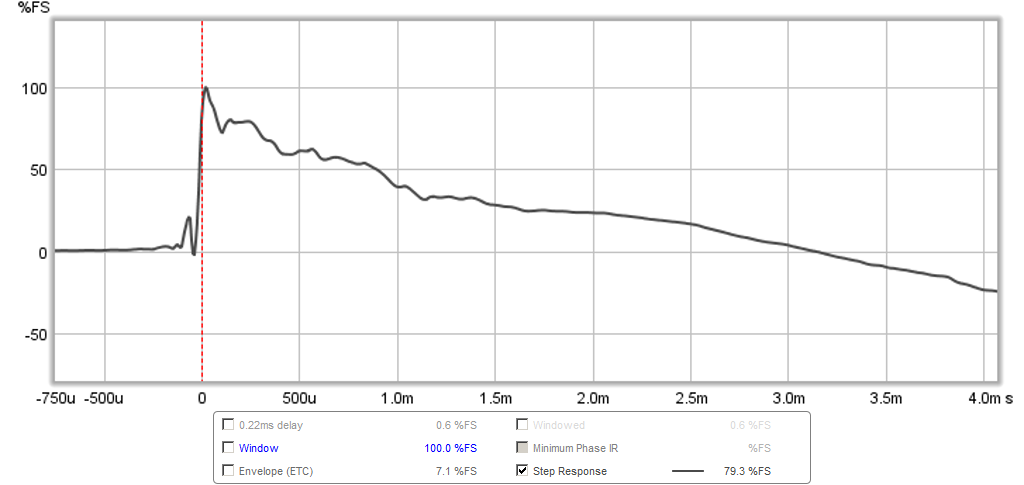
To a well known good performer, the Quad ESL 63:
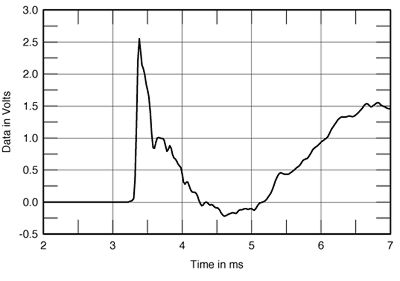
Or even a bare ancestor, the Vifa 10 BGS-119/8:
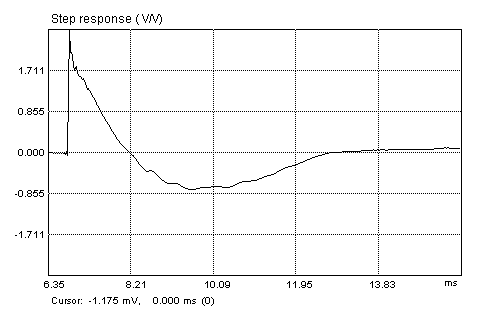
(all different time lines but the general trend is the same. Look at this article for some background. The article probably happened after a talk with John Dunlavy . Ah well, we can throw his chart in here as well;
. Ah well, we can throw his chart in here as well;

From John Dunlavy's papers, note the time scale again. Must be nice to have an anechoic room...
I'd say your speaker is doing a pretty good step response! Still no extra EQ? Only level adjust and cross-over in Minidsp? (Aside from the Linkwitz transform on the bass driver...)
Looks like you got yourself a winner. Now we only need to check the off axis performance to be sure. Waterfall looks clean right? It should with the 10F.
Now get the second one up and running, all this work means nothing if you don't run it in Stereo .
.
If going passive, what do you do for the Bass transform?

To a well known good performer, the Quad ESL 63:
Or even a bare ancestor, the Vifa 10 BGS-119/8:
(all different time lines but the general trend is the same. Look at this article for some background. The article probably happened after a talk with John Dunlavy
From John Dunlavy's papers, note the time scale again. Must be nice to have an anechoic room...
I'd say your speaker is doing a pretty good step response! Still no extra EQ? Only level adjust and cross-over in Minidsp? (Aside from the Linkwitz transform on the bass driver...)
Looks like you got yourself a winner. Now we only need to check the off axis performance to be sure. Waterfall looks clean right? It should with the 10F.
Now get the second one up and running, all this work means nothing if you don't run it in Stereo
If going passive, what do you do for the Bass transform?
Attachments
Last edited:
Wesayso,
Thanks for the background on what a good step response is supposed to look like. I guess I do have a winner! The time alignment was critical to get it clean just 0.26 ms to 0.22ms or 40 microseconds went from good to great. For a passive this probably means having a stepped baffle to get 10F behind the RS225 - kind of like T Graveson's Discovery 3-way monitor. That would avoid a complicated all pass delay. With passive there is really no choice but to put in a port to get some reflex bass action. I'm happy that a first order phase linear XO works. Much in part due to how flat the response of both drivers are through the XO region.
No, there is no EQ apart from the Linkwitz transform and level matching requiring a 6dB amplitude cut on the 10F. It saddens me to throw that kind of sensitivity away but also makes me wonder how run of mill passive speakers with drivers that are not as nice seem to get 88dB sensitivity ratings for the whole speaker?
So I have some help from Byrtt who has designed a passive XO for me that seems to match the measurement above. One thing he suggested trying was to take the predicted filter curve from the passive XO simulator (Xsim) and put it into miniDSP's filter dialog and see if it works before buying the parts. Is this something people do to check out XO's first?
Thanks for the background on what a good step response is supposed to look like. I guess I do have a winner! The time alignment was critical to get it clean just 0.26 ms to 0.22ms or 40 microseconds went from good to great. For a passive this probably means having a stepped baffle to get 10F behind the RS225 - kind of like T Graveson's Discovery 3-way monitor. That would avoid a complicated all pass delay. With passive there is really no choice but to put in a port to get some reflex bass action. I'm happy that a first order phase linear XO works. Much in part due to how flat the response of both drivers are through the XO region.
No, there is no EQ apart from the Linkwitz transform and level matching requiring a 6dB amplitude cut on the 10F. It saddens me to throw that kind of sensitivity away but also makes me wonder how run of mill passive speakers with drivers that are not as nice seem to get 88dB sensitivity ratings for the whole speaker?
So I have some help from Byrtt who has designed a passive XO for me that seems to match the measurement above. One thing he suggested trying was to take the predicted filter curve from the passive XO simulator (Xsim) and put it into miniDSP's filter dialog and see if it works before buying the parts. Is this something people do to check out XO's first?
To get more sensitivity you could pair it with a 15" Altec 416-8B (lol).
Just get the second one up and running to hear what the good step response does for the Stereo signal.
That's why I love the Line Array concept. If I stand up there's still the same coherent sound. The time align works at any position. Granted there is a time smear to consider from the difference to one's ear from the top most driver to the one at ear level. But I haven't been able to determine a negative effect from that in listening. The only way to conquer that would be to make a focussed array, which would loose all the advantages of it's position independent behaviour.
Why are you so eager to make a passive version? Throwing a port into this picture would make it less time coherent. One of these days I want to see what a shallow extention wave guide does for a 3.5" speaker like the 10F. Sort of what Danley did with one of his Synergy Coaxial drivers in the SH100:
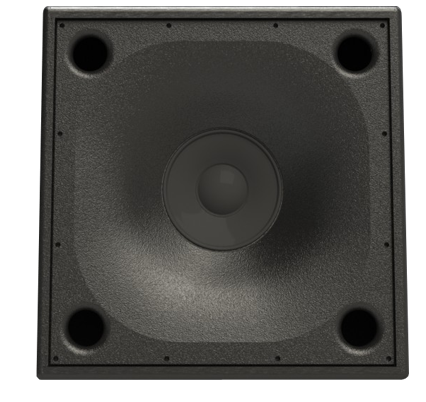
Not to increase the SPL, but rather control directivity. Wondering if it works up to higher frequencies. A 10F in a wave guide like that (easily 3D printed) above one of those Altecs could be huge fun, if it actually works...
Just get the second one up and running to hear what the good step response does for the Stereo signal.
That's why I love the Line Array concept. If I stand up there's still the same coherent sound. The time align works at any position. Granted there is a time smear to consider from the difference to one's ear from the top most driver to the one at ear level. But I haven't been able to determine a negative effect from that in listening. The only way to conquer that would be to make a focussed array, which would loose all the advantages of it's position independent behaviour.
Why are you so eager to make a passive version? Throwing a port into this picture would make it less time coherent. One of these days I want to see what a shallow extention wave guide does for a 3.5" speaker like the 10F. Sort of what Danley did with one of his Synergy Coaxial drivers in the SH100:
Not to increase the SPL, but rather control directivity. Wondering if it works up to higher frequencies. A 10F in a wave guide like that (easily 3D printed) above one of those Altecs could be huge fun, if it actually works...
Attachments
- Home
- Loudspeakers
- Full Range
- 10F/8424 & RS225-8 FAST / WAW Ref Monitor
